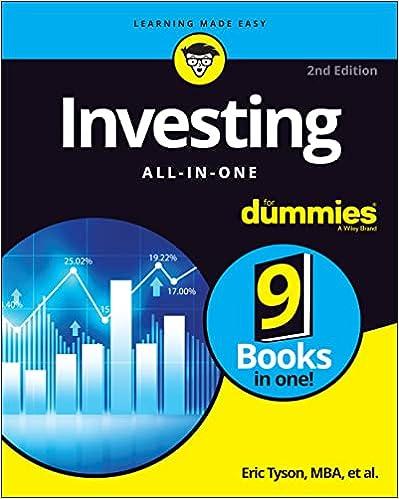Question
The president of the company you work for has asked you to evaluate the proposed acquisition of a new chromatograph for the firms R&D department.
-
The president of the company you work for has asked you to evaluate the proposed acquisition of a new chromatograph for the firms R&D department. The equipments basic price is $85,000, and it would cost another $20,000 to modify it for special use by your firm. The chromatograph, which falls into the MACRS 3-year class, would be sold after 3 years for $40,000. The MACRS rates for the first three years are 0.3333, 0.4445, and 0.1481. Use of the equipment would require an increase in net working capital (spare parts inventory) of $5,000. The machine would have no effect on revenues, but it is expected to save the firm $38,000 per year in before-tax operating costs, mainly labor. The firms marginal federal-plus-state tax rate is 40% and its cost of capital is 11%.
What is the last year's total cash flow without including the operating cash flow?
$7,447 $61,132 $44,555 $32,112 $29,020
-
Although the Chen Companys milling machine is old, it is still in relatively good working order and would last for another 5 years. It is inefficient compared to modern standards, though, and so the company is considering replacing it. The new milling machine, at a cost of $50,000 delivered and installed, would also last for 5 years and would produce after-tax cash flows (labor savings and depreciation tax savings) of $14,000 per year. It would have zero salvage value at the end of its life. The firms WACC is 11%, and its marginal tax rate is 35%. What is the NPV of the new machine?
$6,747 $20,000 $1,743 $1,540 $80,000 -
The Yoran Yacht Company (YYC), a prominent sailboat builder in Newport, may design a new 30-foot sailboat based on the winged keels first introduced on the 12-meter yachts that raced for the Americas Cup.
First, YYC would have to invest $5,000 at t = 0 for the design and model tank testing of the new boat. YYCs managers believe there is a 70% probability that this phase will be successful and the project will continue. If Stage 1 is not successful, the project will be abandoned with zero salvage value.
The next stage, if undertaken, would consist of making the molds and producing two prototype boats. This would cost $400,000 at t = 1. If the boats test well, YYC would go into production. If they do not, the molds and prototypes could be sold for $100,000. The managers estimate the probability is 75% that the boats will pass testing and that Stage 3 will be undertaken.
Stage 3 consists of converting an unused production line to produce the new design. This would cost $1 million at t = 2. If the economy is strong at this point, the net value of sales would be $4 million; if the economy is weak, the net value would be $2.5 million. Both net values occur at t = 3, and each state of the economy has a probability of 0.5. YYCs corporate cost of capital is 12%.
Assume this project has average risk. What is the NPV of the scenario that goes from the start and ends with YYC going through with the new sailboat and facing weak economy in the end?
($185,952) ($5,000) $117,779 $1,095,000 $620,114
Step by Step Solution
There are 3 Steps involved in it
Step: 1

Get Instant Access to Expert-Tailored Solutions
See step-by-step solutions with expert insights and AI powered tools for academic success
Step: 2

Step: 3

Ace Your Homework with AI
Get the answers you need in no time with our AI-driven, step-by-step assistance
Get Started


